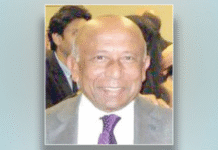Don’t believe everything you read about a BJP landslide
As India approaches the D-day of May 16, 2014 a critical question that needs to be answered is that which of the two parties, the Indian National Congress (INC) or the Bharatiya Janta Party (BJP), is better at the art of skullduggery; something that is increasingly looking like a necessary requirement for the formation of the next government in India.
For anyone who thinks that the BJP is on a comfortable path to forming the next government, this electoral analysis will probably be a bit of a shocker. The BJP will certainly come close, but whether it is actually able to form the government will depend on how good it’s “numbers managers” are in the middle of May. I can, from personal experience state without any hesitation that, when it comes to managing numbers the BJP always loses to the INC.
Let us take a look at some of the numbers which led me to draw this conclusion. Contrary to the belief held by a lot of political pundits that the BJP will win somewhere close to 225 seats on its own; I tend to put this number at 175 at best. The pre-poll alliances that the BJP has been able to enter into with other parties that constitute the BJP-led National Democratic Alliance (the NDA) will take the number of seats won by the alliance to around 207.
The INC-led United Progressive Alliance (the UPA) is expected to not perform as well as it did in the last elections but in my opinion they will not perform as bad as some people may have us believe. The INC should be able to win around 122 seats, taking the seat tally of the UPA to around 148. What this leads to is a stark reality that about 188 seats will be won by parties that are in neither of the alliances.
These parties can be split into two sub-groups: one that will never support the BJP, such as the Left Front led by the Communist Party of India, Marxist (the CPM), the Samajwadi Party (SP), Janta Dal United (JDU), et al; and a group such as the Bahujan Samaj Party (BSP), the All India Trinamool Congress (AITC), the All India Anna DMK (AIADMK) who may or may not support the BJP.
The group of parties that will never support the BJP will end up commanding a strength of 87 seats. This is where the government forming predicament of the BJP starts to gain strength. The total number of seats held by parties opposed to the BJP-led alliance forming the government ends up being close to 235; just 37 seats shy of the magic number of 272.
It is at this juncture that the role of three parties, the BSP, the AITC, and the AIADMK becomes critically important. The three of them should be able to win seats in the following order: BSP – 30, the AIADMK – 28, the AITC – 25. Let us analyse what the three of them will do. Two questions will be asked by the leaders of these three parties when asked to support either the NDA or the UPA:
1. What’s in it for me?
2. What’s in it for my party?
Since all these three parties are a “one woman show” the second question sort of loses relevance if the first question is answered satisfactorily. All three of them have done business with the BJP and the INC at one point or the other so there will be no qualms about getting their pound of flesh. So now let’s see which group – the NDA or the non-NDA – will these three gravitate towards.
In reality only two out of three are needed under all scenarios. The NDA cannot offer any one of them the coveted top job – the post of the PM. But the non-NDA group can easily offer them the PM’s job under the excuse of keeping Narendra Modi out. This makes the NDA a little bit of less attractive for all these three women.
Out of these three women, two of them – J Jayalalitha (leader of the AIADMK of Tamil Nadu) and Mamata Banerjee (leader of the AITC of West Bengal) – are sitting CMs so they will not accept anything less than the post of the PM. What further complicates things for the BJP-led NDA is that both these leaders have to take into account local and state issues that form the backbone of their political fortunes before supporting any alliance.
For example, why would Mamata whose state is home to the second largest Muslim population in the country, offer support to a “Hindu” national party? The Muslims in West Bengal have supported the AITC en bloc and this is one of the reasons why the AITC has a brutal majority in the state assembly. Why would Mamata or her party risk annoying this voter base? Jayalalitha’s stated position on the conduct of India’s foreign policy with regards to Sri Lanka is in direct conflict with the BJP’s stated position of strengthening relations with India’s neighbours. The point being made here is that even if these two parties were to initially support the NDA there would be an unending list of irritants which will continue to threaten the stability of the government.
Mayawati, the leader of the BSP, who at this moment is not in power, will be reasonably easier to deal with at the negotiating table although the BJP does refer to its earlier alliance in UP with the BSP as the biggest mistake committed by the BJP.
While one can argue that some components of the non-NDA group like the SP and CPM will not let the likes of BSP or the AITC rule the roost; they won’t have too much of a choice when confronted with the prospect of being held responsible for letting the Narendra Modi led NDA come to power. They can agree to abstaining from voting in parliament at key junctures such as when a motion of confidence is moved.
Apart from the fact that the NDA cannot offer the top job to anyone in return for support, one more impediment for the BJP-led NDA will be the fear the smaller parties will have for the governance of Narendra Modi. These small regional parties thrive because of the instability.
If a person like Narendra Modi were to be put in-charge of the state of affairs and he accidentally does deliver on the promise of good governance, then these smaller regional parties would have signed their own death warrant.
Thus, supporting a combination that furthers the political instability in the country will be a much more attractive option than supporting someone who just might lead the country towards some semblance of stability.
At this point it would be prudent to address the question as to why the BJP will not cross the 200 mark all by itself. My reasons are that BJP made five critical mistakes, and there isn’t any time left to correct those mistakes:
1. It faltered in ticket distribution; specially in key states like UP and Bihar where too many turncoats were given the party tickets.
2. It failed to execute the plan it had conceptualised; specially in key states like UP and Bihar
3. It failed to control in-fighting among its leaders – both at state level and national level.
4. In its efforts to boost the number of parties in the NDA it ran after insignificant sub-regional parties, thereby negating their claim that a “Modi wave” was sweeping the country. The number of parties (leaving aside the SS and SAD) that the BJP could get under the NDA umbrella far exceeds the number of seats these parties will get.
5. It lost critical time in announcing its final list of candidates
The limitation that the BJP has is that it can only perform in a limited number of states on its own where it matters electorally: Gujarat, Madhya Pradesh, Rajasthan, Bihar, UP, Delhi, Uttrakhand, Chhatisgarh, Himachal Pradesh, and Karnataka. Out of these states, in Madhya Pradesh, Gujarat and Rajasthan it will win almost 90% of the seats and it was critical for it to perform equally well in UP, Bihar and Karnataka.
Let us first look at UP. Whether one likes it or not, after the recent riots in UP the polarisation of votes was pretty much a done deal. The Jaats in Western UP were rock solid behind the BJP and all that the BJP needed to do was put up the right candidates to take advantage of the mood of the electorate. Instead, the in-fighting that was on public display just added to the misery of botching up the “done deal.”
For example, where was the need for the BJP president to abandon his seat in Ghaziabad and run away to Lucknow leaving the seat to a new comer VK Singh? In Mathura, Jayant Singh of the RLD was a sure shot loser but the BJP put up Hema Malini against him and pretty much lost that seat.
Could they not find a suitable or local Jaat leader to contest against Jayant Singh? Hema Malini cannot even find the keys to the party office leave alone find the voters. Where was the need to give party tickets to people like Meenakshi Lekhi (New Delhi), Kirron Kher (Chandigarh), Mahesh Girri (East Delhi)?
Moving on to Bihar. The BJP made a critical mistake in leaving 10 seats out of 40 for Ram Vilas Paswan and Upendra Kushwaha – two people whose parties do not have even one seat between them in either the State legislature or the parliament. Where is the guarantee that after the elections these two people will be loyal to the BJP?
It cannot play the “upper caste and lower caste” card at the same time. After the split with the JD(U), a considerable number of upper castes were starting to align behind the BJP but after the alliance with Paswan and Kushwaha those upper castes started to have second thoughts. Added to this is the fact that the Yadav vote bank is standing firm behind Lalu Yadav.
The INC-RJD alliance is all of a sudden looking like a formidable challenge against the BJP. The issue of turncoats getting the party tickets also continues to annoy the local cadre. The main problem that the BJP faced in Bihar was that since it had not contested all 40 seats in the state for almost two decades – having been involved in a now-broken alliance with the JDU for 17 years – BJP suddenly found itself short of candidates to put up in constituencies that had been represented by the JDU earlier.
The sum conclusion of all this, in my opinion, is that the Congress will be able to block the chances of a Narendra Modi led NDA from forming the government by supporting any combination of parties that will want to stand up against Narendra Modi after the election results are declared. The numbers, coupled with critical mistakes made by the BJP, support this contention. The BJP will have to literally pull a magical rabbit out of the hat to form the government.
Source: Dhaka Tribune










